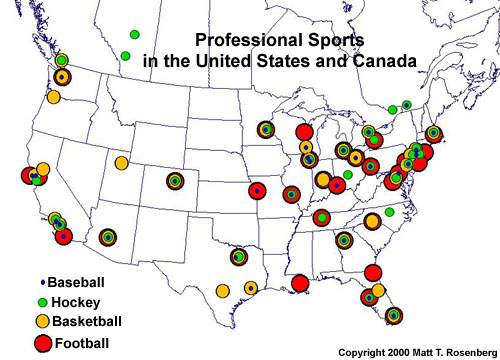Structure, roles, relationships
The structure (dimension 4) reveals the inequality of internal fragmentation of space (figure 4). It is homogeneous, diversified and specialised. Regions with larger number of population are more diversified (many sports are done at the same time) than those of with smaller numbers. Diversity is evident in case of different landscapes, such as, plains, mountains and sea shores. Alpine environment offers special sports. The dynamic spatial background involving time as a variable result in the increase of homogenization, unification and differences.

Figure 4. The structure of the professional sport of the USA and Canada based on the four main sports.
Roles (dimension 5) mean the ranks of spatial elements in the system and their functions as well as activities. This division of labour can be well identified within this system (e.g.: the venues of sports management, sports academies and junior education associations). They function both in space and time. The bigger cities and metropolises are functionally much richer than the smaller towns and settlements.
Relationships (dimension 6) reflect the interaction of the elements (commuting among regions, towns, migration and integration). Various relationship networks belong to each sport. The spatial and functional connections of popular sports are much richer than the new ones as well as the “elderly” sports which have already lost popularity.
Conjuncture (dimension 7) involves the above and below spatial subordination, directive-subservient of roles and their interrelationships. All these are analogical connection with quantity and quality dimensions (Nemes Nagy, 1998).
The seven dimensions applied for the spatial analysis of sports just like in case of studying social-cultural phenomena within other research areas occur together in a given time cross-section. At the same time the relationship among variables based on these seven dimensions are not deterministic but stochastically.